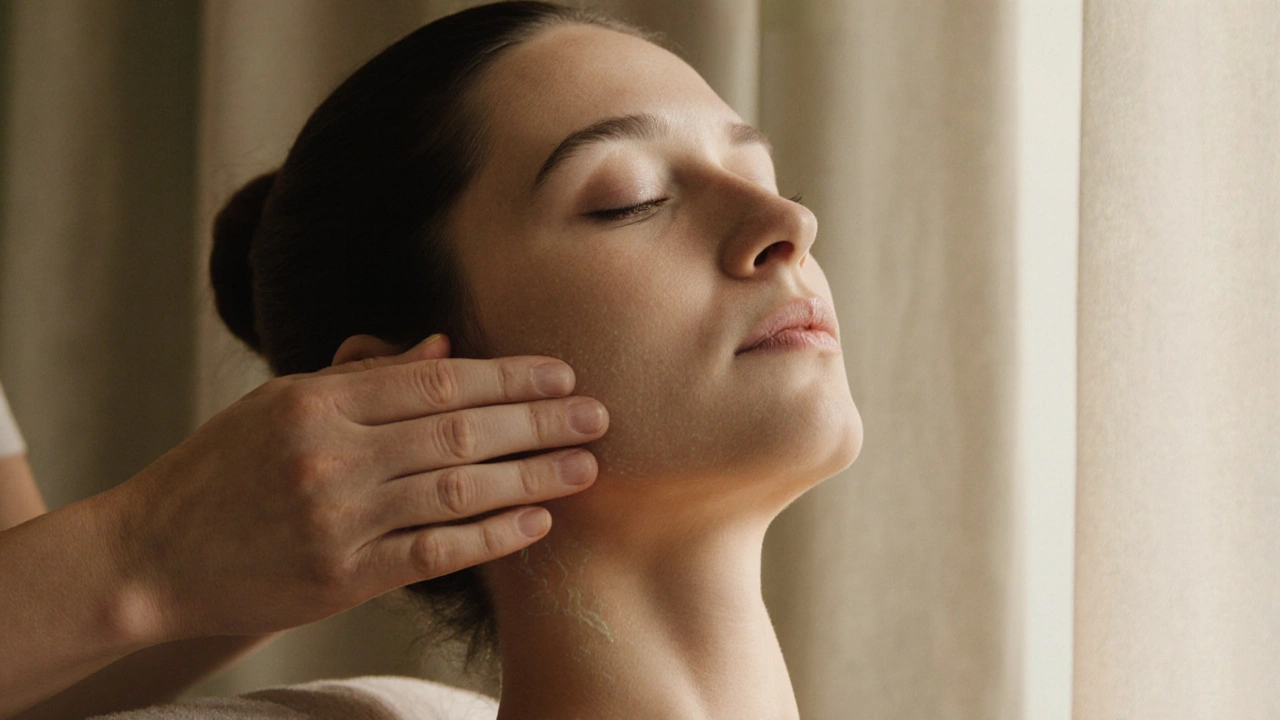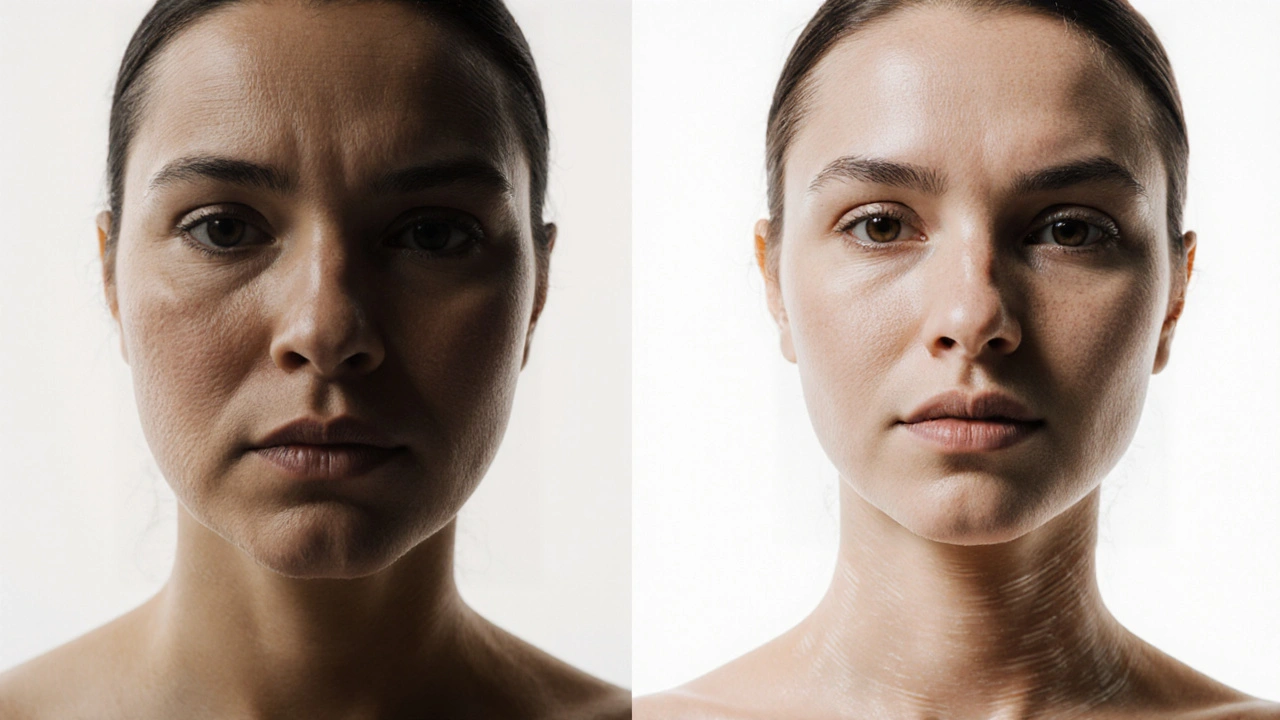Lymphatic Drainage Massage: Boost Your Natural Glow and Reduce Bloating

Ever wake up with puffy eyes, a swollen face, or legs that feel heavy even after a full night’s sleep? It’s not just lack of sleep. It’s your lymphatic system struggling to keep up. Lymphatic drainage massage isn’t a luxury spa trick-it’s a quiet, powerful reset for your body’s natural cleanup crew. And yes, it can make your skin look brighter, your face less puffy, and your whole body feel lighter-all without needles, pills, or extreme diets.
What Exactly Is Lymphatic Drainage Massage?
The lymphatic system is your body’s hidden plumbing. Unlike blood, which the heart pumps, lymph fluid moves slowly, pushed by muscle movement and gentle pressure. It carries waste, excess fluid, toxins, and even immune cells out of tissues. When it slows down-because you’re stressed, sedentary, or dehydrated-fluid builds up. That’s when you get puffiness, dull skin, or that ‘I’ve been hit by a truck’ feeling.
Lymphatic drainage massage uses ultra-light, rhythmic strokes-think the weight of a dollar bill-to encourage this fluid to flow. It doesn’t crush muscles like deep tissue. It doesn’t use oils to glide over skin. It’s slow, precise, and deliberate. A trained therapist follows the exact paths lymph flows: behind the ears, down the neck, along the collarbones, and into the armpits and groin. These are your body’s main lymph node clusters.
It’s not magic. It’s physiology. A 2023 study in the Journal of Clinical and Aesthetic Dermatology found that participants who received weekly lymphatic drainage massage for four weeks saw a 28% reduction in facial swelling and improved skin elasticity. No lasers. No fillers. Just better fluid movement.
Why It Works for Your Skin and Face
Most people think of lymphatic massage as something for post-surgery recovery or swollen ankles. But the face? That’s where it shines.
Your facial skin is thin. It holds onto fluid easily. Salt, alcohol, poor sleep, or even sleeping on one side can trap water under your eyes and along your jawline. Lymphatic drainage gently redirects that fluid toward your neck, where your body can flush it out.
Think of it like unclogging a sink. If water backs up, you don’t scrub harder-you clear the pipe. That’s what this massage does. It opens the drainage pathways so your skin can breathe and renew itself. Over time, you’ll notice:
- Less morning puffiness around the eyes
- A sharper jawline
- Reduced under-eye circles (from fluid buildup, not just tiredness)
- Softer texture and a subtle glow
It’s not a replacement for skincare. But it’s the missing step most people skip. You can use a jade roller or gua sha tool at home-but those are helpers. Real lymphatic drainage needs the right pressure, rhythm, and direction. Too much pressure blocks the flow. Too little does nothing.
How Often Should You Get It?
You don’t need to book a session every week. But consistency matters more than intensity.
If you’re new to it, try one session a week for four weeks. That’s enough to reset your system. After that, once every two to four weeks is enough to maintain the benefits. People who deal with chronic sinus issues, hormonal bloating, or postpartum swelling often find monthly sessions life-changing.
At-home routines help too. Spend five minutes each morning gently massaging your face in upward strokes-from your chin to your ears, from your eyebrows to your temples, and from your nose outward. Use your fingertips, not your nails. Keep the pressure feather-light. Do it before applying moisturizer. You’ll feel the difference within days.

Who Should Avoid It?
It’s safe for most people. But not everyone.
Avoid lymphatic drainage massage if you have:
- An active infection or fever
- Heart failure or severe kidney disease
- Recent blood clots or deep vein thrombosis
- Untreated cancer (especially if lymph nodes are involved)
- Active skin infections, open wounds, or severe eczema in the area
If you’re pregnant, it’s generally safe-but only if done by someone trained in prenatal lymphatic work. Avoid deep pressure on the abdomen or inner thighs.
Always tell your therapist if you’re on medication, especially diuretics or blood thinners. They’ll adjust the technique accordingly.
What to Expect During a Session
Most sessions last 60 to 90 minutes. You’ll lie on a massage table, fully clothed or in light cotton garments. No oils. No loud music. Just quiet, slow movements.
The therapist will start at your collarbones and work down your arms, then move to your neck and face. Each stroke is repeated 3 to 5 times. You might feel a slight tingling or warmth. Some people feel oddly tired afterward-like they’ve just had a deep meditation. That’s normal. Your body is processing what’s been released.
Drink water after. Lots of it. It helps flush out the toxins and fluids that were moved. Skip caffeine and alcohol for the rest of the day. Your liver will thank you.
Real Results, Not Just Trends
I’ve seen clients come in with chronic facial swelling from thyroid issues. After six sessions, they stopped needing to wear foundation to cover puffiness. Another client, a nurse working 12-hour shifts, noticed her legs didn’t ache by Friday anymore. She started doing self-massage daily and now sleeps better.
This isn’t about looking younger. It’s about feeling lighter. It’s about your body doing what it was designed to do-clean itself-without you having to force it.
Lymphatic drainage massage doesn’t promise miracles. But if you’ve tried everything else and still feel bloated, dull, or heavy, this might be the quiet solution you’ve been overlooking.

How to Find a Good Therapist
Not every massage therapist knows how to do this right. Look for someone with specific training in Manual Lymphatic Drainage (MLD). Certifications from the Vodder School, the Lymphology Association of North America, or the British Lymphology Society are strong indicators.
Ask: “Do you follow the Vodder method?” That’s the gold standard. If they say yes, ask how long they’ve been practicing it. Someone who’s done 500+ hours of training is far more reliable than someone who took a weekend course.
Price varies. In Bristol, expect £60-£90 for a 60-minute session. Don’t go cheaper unless you’re sure of their training. Poor technique can do more harm than good.
DIY at Home: A Simple Routine
You don’t need a therapist every day. Here’s a 5-minute morning routine you can do with clean fingertips:
- Start at your forehead. Gently press and glide from the center out to your temples. Repeat 3 times.
- Move to under your eyes. Use your ring finger. Lightly press from the inner corner toward your temple. Do this 3 times.
- From the tip of your nose, glide outward toward your ears. Repeat 3 times.
- Place your fingertips under your jawline. Gently glide upward toward your ears. Repeat 3 times.
- Finally, press lightly behind your ears and slide down your neck toward your collarbones. Do this 5 times.
Do this before applying anything to your skin. It takes less time than brushing your teeth-and it works better than any serum for reducing morning puffiness.
Can lymphatic drainage massage help with cellulite?
It can reduce the appearance of cellulite temporarily by moving trapped fluid and improving circulation. But it won’t eliminate fat or permanently change skin structure. For lasting results, combine it with movement, hydration, and healthy eating.
Is lymphatic drainage massage the same as a regular facial?
No. A regular facial cleanses, exfoliates, and moisturizes the skin’s surface. Lymphatic drainage works beneath the skin-targeting fluid buildup and waste removal. It’s deeper, slower, and doesn’t involve masks or steam.
How soon will I see results?
Many people notice reduced puffiness after one session. For lasting skin glow and reduced bloating, plan for 3-4 sessions over a month. Consistency is key.
Can I do lymphatic massage after plastic surgery?
Yes-many surgeons recommend it after procedures like facelifts, liposuction, or breast surgery. It helps reduce swelling and scar tissue. But always wait until your surgeon gives clearance, usually 1-2 weeks post-op.
Does lymphatic drainage detox the body?
It supports your body’s natural detox process by moving lymph fluid, which carries cellular waste. But it doesn’t remove toxins like a juice cleanse. Your liver and kidneys handle detox. Lymphatic massage just helps them work more efficiently.
Next Steps: Try It
If you’ve been ignoring that morning puffiness or feeling sluggish without knowing why, give lymphatic drainage a real try. Book one session. Do the 5-minute routine for a week. Drink more water. See how your skin and energy feel.
This isn’t about chasing beauty trends. It’s about listening to your body’s quiet signals-and helping it do what it already knows how to do.



connor dalton
November 1, 2025 AT 01:13I've been doing the 5-minute facial routine every morning for two weeks now. My eyes don't look like I've been crying since 3 a.m. anymore. It's not a miracle, but it's the first thing that actually reduced my puffiness without me having to buy ten different serums.
Also, I started drinking more water after and honestly? My skin feels less tight. Like, actually hydrated, not just surface-level.
Not sure why more people don't talk about this. It's free, takes five minutes, and doesn't require a prescription.
Kari Watkins
November 2, 2025 AT 05:20OMG I JUST DID THIS FOR THE FIRST TIME LAST WEEK AND MY FACE LOOKS LIKE A DIFFERENT PERSON?? 😭😭😭
Like, I went from ‘I woke up after a hurricane’ to ‘did someone airbrush me??’
I’m not even kidding. My jawline? Suddenly a thing. My under-eye circles? Gone. I’m not even wearing makeup today and I feel like I won the lottery.
Also, I bought a rose quartz roller and now I do it while listening to lo-fi. It’s my new therapy. I’m basically a goddess now. 🌸✨
Emily Cross
November 3, 2025 AT 20:47Let’s be real - this isn’t ‘physiology.’ It’s placebo with a fancy name.
The study cited? Tiny sample size, no control group, funded by a spa chain. You think lymphatic massage ‘unclogs’ your face like a sink? That’s not how biology works. Fluid doesn’t just ‘back up’ because you slept on your side.
And ‘feeling lighter’? That’s just hydration and reduced salt intake. You’re not detoxing. Your liver’s doing its job. You’re just massaging your face and calling it science.
Also, ‘no oils’? That’s just a marketing gimmick to make it sound mystical. Any pressure on skin moves fluid. Even scratching your nose does. This is just glorified rubbing.
But sure. Keep buying $90 sessions. I’ll be here, saving my money and trusting my kidneys.
Amit krishna Dhawan
November 4, 2025 AT 16:27This is beautiful. I work as a nurse in Mumbai and see so many patients with swollen legs from standing all day - they never think it’s lymphatic. We teach them this simple technique after shifts.
One lady, 68, had swelling since her knee surgery. After three weeks of doing the neck-to-collarbone strokes daily, she stopped using her compression socks. She cried when she saw her legs for the first time in months.
It’s not magic. It’s respect for the body’s own system. Why do we always think we need something expensive or invasive? Sometimes the answer is just gentle touch.
Thank you for writing this. I’m sharing it with my whole ward.
Abhishek Gowda
November 6, 2025 AT 15:53bro i did this after my breakup and it was the only thing that made me feel human again 🥲
like i was crying every night and my face was puffy as hell and i just sat there and did the 5-minute thing and for the first time in weeks i felt… calm?
not like, ‘oh i’m healed’ but like… my body finally stopped screaming.
now i do it while watching anime. it’s my peace ritual. i love you whoever wrote this. you saved me.
Ashok kumar
November 7, 2025 AT 21:14And yet… no one talks about the elephant in the room: the fact that this entire practice was developed in 1930s France by a man who believed in ‘vital fluids’ and was rejected by mainstream medicine for decades!
Now? It’s a $200-per-session trend because influencers say ‘glow up’ - but the original intent? Spiritual balance. The Vodder method? Not just technique - it’s a philosophy of stillness, of listening to the body’s rhythm, not forcing it.
And you think you’re ‘cleansing’? You’re not. You’re participating in a quiet rebellion against the hustle culture that tells you to ‘fix’ yourself with chemicals, lasers, and 3 a.m. workouts.
People don’t want to hear this - they want a product. But real healing doesn’t come in a bottle. It comes in silence. In pressure so light, it’s almost not there. In patience.
And if you’re doing it for ‘glow’? You’re missing the point entirely.
...I’m not mad. I’m just disappointed.
Amal Benkirane
November 9, 2025 AT 00:28I tried this after my baby was born. My face was so swollen I didn’t recognize myself. I did the routine every morning and after two weeks, I felt like I could breathe again.
It didn’t fix everything. But it helped me feel like me again.
Thank you for explaining it simply. I’m not a science person, but this made sense.
Also, I started drinking more water. Small things add up.
Kelly O'Leary
November 9, 2025 AT 19:18I’ve been doing this for years since moving from Ireland to the US - I noticed how many people here think ‘self-care’ means expensive products or intense routines
But this? This is the quietest kind of care. No noise. No pressure. Just gentle movement and a little patience
My therapist in Galway taught me to do it before bed too - not just morning. It helps with sleep
Don’t overthink it. Just try it. And drink the water
Kathryn MERCHENT
November 10, 2025 AT 19:27Look I get it you guys love your spa nonsense but this is just another way Americans waste money on pseudoscience
My cousin in India does this with a spoon and coconut oil and she’s fine
Why are we paying $90 for someone to touch our face? We’re not dying of lymphatic failure
Just stop drinking soda and sleep on your back and you’ll be fine
Stop buying into this wellness cult